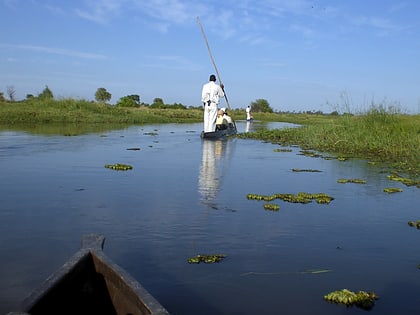Okavango Delta


Facts and practical information
The Okavango Delta in Botswana is a breathtaking natural wonder, renowned for its sprawling floodplains and rich biodiversity. This inland delta, formed where the Okavango River meets a tectonic trough in the central part of the endorheic basin of the Kalahari, is unique because it does not flow into the sea. Instead, its waters spread out into a complex system of channels, lagoons, and islands, covering between 6,000 to 15,000 square kilometers of the Kalahari Desert.
Declared a UNESCO World Heritage Site in 2014, the Okavango Delta is one of the few major interior delta systems that do not have an outlet to the sea, leading to the nickname "the river that never finds the sea". Its annual flooding, which occurs during the dry season, supports an ecosystem that is incredibly diverse and attracts large numbers of African mammals, including the rare and endangered species such as the cheetah, white rhinoceros, black rhinoceros, African wild dog, and lion.
The delta is also home to over 400 species of birds, making it a haven for birdwatchers. The dynamic pattern of flooding, drying up, and re-flooding ensures that the region offers a variety of habitats, from dry woodlands to wetlands, which support a remarkable variety of plant and animal life. The area is largely unmodified by human activity, offering an exceptional example of the interaction between climatic, hydrological and biological processes.
Tourism in the Okavango Delta is a significant part of Botswana's economy, with visitors coming from all over the world to experience its pristine wilderness. Activities include guided game drives, walking safaris, and mokoro (dugout canoe) trips through the winding waterways. The delta's intricate network of channels and islands can be best appreciated from the air, and scenic flights are a popular way to take in the vastness and beauty of this extraordinary landscape.
North-West
